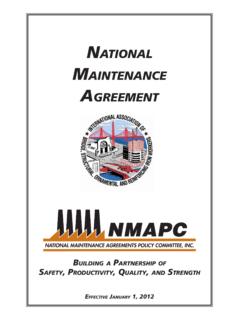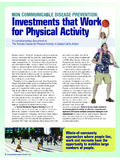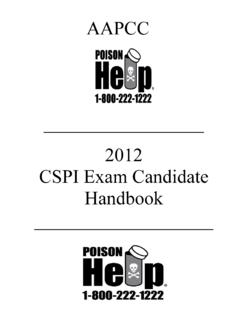Transcription of The Influence of Human Performance on Safety - …
1 The Influence of Human Performance on Safety Bob Fitzgerald Manager Project Safety and Health DISCLAIMER! This is NOT meant to be an all-inclusive HP Training Session! DISCLAIMER! This is NOT meant to be an all-inclusive HP Training Session! Just enough to whet your appetite! Southern Company Atlanta-based and serving the southeast million customers and nearly 46,000 megawatts of generating capacity Parent Company for Electric Utilities: Alabama Power Georgia Power Gulf Power Mississippi Power Southern Power Southern Nuclear Employing over 26,000 people and serving 120,000 square miles Engineering & Construction Services Basically, E&CS provides a Project Management function for Southern Company Operations Provides: Design Engineering Project Management Services Currently, ~1,500 Employees managing 16 projects across the Southeast Managed around ~125 MM contractor work hours in last seven years Serves New Generation, Environmental, and Retrofit groups of our business Any one day around 4,000- 6,000 craft are on our projects What Human Performance is NOT.
2 NOT a Performance Management Tool NOT an excuse for not holding workers accountable NOT a substitute for existing Operational Excellence efforts =. NOT a substitute for existing Safety efforts What is Human Performance ? Human Performance is an operating philosophy which acknowledges that people make mistakes. It identifies causes of Human errors and provides specific tools to help eliminate them. Human Performance empowers employees, regardless of title or tenure, to contribute equally to the Safety and operational excellence of our organization. What is Human Performance ? Human Performance is the way people think about and perform their work. Behaviors + Results = Human Performance (How) (What). A strong focus on the reduction of the frequency and lowering of the severity of Human error Benefits of HP: How it helps 1. Provides tools & techniques to minimize errors and prevent harm 2. Helps focus our mental approach for doing safe work More Deliberate thought and action Better Awareness of potential consequences and Risks Improved recognition of error-likely situations and error traps 3.
3 Enables us to get it done right, the first time, safely doing quality work, that produces reliable & timely results Purpose of Human Performance Focus To proactively prevent events triggered by Human error What is an Event ? The undesirable result of an error. Any undesirable or unwanted result or outcome involving serious harm to the individual, other assets, and/or an organization. An undesirable change in the state of structures, systems, products, services (assets) that involve serious degradation or termination of its ability to perform its required function. 10. A Critical Step is defined as: A task action that, if done incorrectly or not at all, would result in an unrecoverable condition affecting safe-quality-reliable job completion. A step is critical if it has one of the following characteristics: Consequence - from incorrect Performance : * injures personnel * damages equipment * harms public Irrecoverable - can't be re-performed, if performed incorrectly 11.
4 Principles of Human Performance 1. People are fallible and make mistakes, even the best . 2. Individual behavior is influenced by organizational processes and values 3. Error/Mistake-likely situations are predictable and manageable 4. Incidents (Operational and Personal) can be avoided by understanding mistakes and learning from them 5. Leadership response to failure matters (How you react matters!). 5 Principles . The five principles serve as the firm foundation regarding the way employees are trained and coached in their every day work environment. (Active Error Elimination). The five principles are used to design the organizational structure that employees rely on to manage the business, make the product, and operate safely. (Latent Error Elimination). Human Performance Principle 1: People make mistakes, even the best make mistakes. What is an error? An error is an unintentional departure from an expected behavioral standard.
5 An intentional departure is a violation. Human Errors Two-thirds of all aviation accidents and incidents 92% of car crashes (10mil/Yr) ( Census Bureau). 44,000- 98,000 deaths in Hospitals result from Human errors (Institute of Medicine). Operational Upset: A condition that adversely Human Errors affects or may affect the organization, the people, or the mission. 70%. System Induced Error Operational Upsets 30%. 90% Individual Human Error 10% Error Equipment Issues Origin of Human Error Human Error Exercise How many times does the letter f appear in the following sentence? Finished Finished files are the files are the re- re- sult sult of years of of years of scientific scientific study study combined combined withwith the the experience experience of many years. of many years. Limitations of Human Nature Mistakes arise directly from the way the mind handles information, not through stupidity or carelessness.. -Edward de Bono PhD.
6 Raednig is esay Aoccdrnig to rscheearch at an Elingsh uinervtisy, it deosn't mttaer in waht oredr the ltteers in a wrod are, the olny iprmoetnt tihng is taht the frist and lsat ltteer is at the rghit pclae. The rset can be a toatl mses and you can sitll raed it wouthit porbelm. Tihs is bcuseae we do not raed ervey lteter by it slef but the wrod as a wlohe. US Highway Fatalities Vehicle Highway Near Misses & Close Calls are a GIFT!! Near Misses &. Close Calls MISTAKES are not a choice. Mistakes =. Violations Human Performance Principle 2: Individual Behavior is influenced by organizational processes and values. Workplaces and organizations are easier to manage than the minds of individual workers. You cannot change the Human condition, but you can change the conditions under which people work. Dr. James Reason Defenses in Depth Redundancy: many layers of protection. Diversity: many different varieties of protection.
7 Independence: separate/autonomous layers of protection. Dr. James Reasons Human Performance Principle 3: Mistake-likely situations are predictable and manageable. Mistakes are NOT. predictable, But the environment in which mistakes may happen is. Predictability What will the next unwanted event be in your organization? Where will this event take place? Human Performance Principle 4: Incidents (Operational and Personal). can be avoided by understanding mistakes and learning from them How We See Events Old View New View Human error is a cause of Human error is a symptom of trouble accidents deeper inside a system To explain failure, investigations To explain failure, do not stop at must find failures of systems or where people went parts of systems Instead, find out how peoples' actions These investigations must find and assessments made sense at the inaccurate assessments and bad time given the circumstances that decisions surrounded them.
8 Work as Imagined vs. Work in Practice Management's Stated Expectations Drift Hi Margin for Error Normal . Practice Real Reliability Margin for Error Actual Threats to Reliability Perceived Threats to Reliability Time Lo Human Performance Principle 5: Leadership's response to failure matters. 8 Questions A Manager Should Ask 1. Are the people ok? 2. Is the facility safe and stable? 3. Tell me the story of what happened? 4. What could have happened? 5. What factors led up to this event? 6. What worked well? What failed? 7. Where else could this problem happen? 8. What else should I know? Discipline and Accountability 1. Was the learning event done before the discipline? 2. Is the discipline being considered consistent with past practice? Was past practice appropriate? 3. Would discipline normally be issued (based on this behavior). even if there was not an incident? 4. Was the work activity bypassing a normal procedure (without an approved work-around document)?
9 5. Was the situation complex; requiring adaptation? 6. Was the action a willful, intentional violation? The purpose of an Investigation should be to prevent recurrence, not to find people to blame . Investigations should really be titled Learning Events! . The Key Event Prevention Happens Through Learning Successful organizations do 4. things well: 1. Constantly fixate on the next failure. 2. Work hard to reduce operational complication 3. Respond deliberately to actual events. 4. Respond seriously to precursor information. What can we do about it? Behavioral Standards = HU Tools! Individual Tools Team Tools Self Checking (STAR) Pre-Job Brief Questioning Attitude Coaching Procedure Usage Effective Communications Place Keeping Turnover Post-Job Review Peer Checking Human Performance Toolkit 1. Work Planning 2. Pre/Post Job Briefing 3. One Minute Matters 4. Procedure Use 5. Task Verification 6. Time Out 7. 3 Part Communication 8.
10 Flagging Human Performance Tools To Combat Error Traps Stop When Uncertain Questioning Attitude Peer Checking/Self Checking Procedure Use and Adherence 3-Way Communications Pre-Job Briefing and Post-job Review 44. STOP. When Uncertain Do you have any questions? What is the Policy? What is the Procedure? Is there a safe plan to perform this task? Is there anything unsafe about this task Are you unsure of directions that have been given? 45. Questioning Attitude 46. Peer Checking Peer checking engages an equally qualified person as a second verifier of the activity to be performed;. thereby reducing the probability of error. 47. Self-Check using S-T-A-R. Stop -- Pause to focus your attention. Think -- Understand what is being done and the potential outcomes, so you can decide what to do if the expected results do not occur. And, think about the situation (critical steps and error traps), so you can determine what and how many barriers or defenses you'll need in place to protect you.










